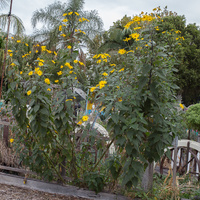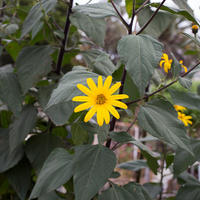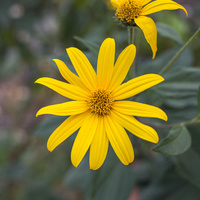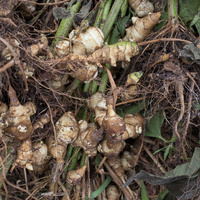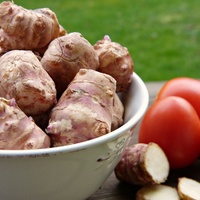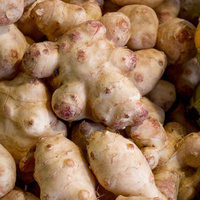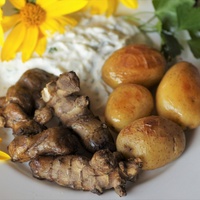Common name: Jerusalem artichoke
Other common names: Canada potato, Sunchoke, Woodland sunflower
Description
Native to North America, this perennial herb is closely related to the Sunflower (Helianthus annuus) and is cultivated for its tubers, which are cooked and eaten as a vegetable.
From the underground tubers sprout clumps of tall, slender green stems. In highland tropical areas, these reach up to 1 to 1.5 m (3 to 5 ft) tall, about half the height they usually grow to in subtropical and temperate regions. Set along the stems and on long leaf-stalks are dark green, ovate-leaves 13 to 25 cm (5 to 10 in) in length. These are finely toothed on the margins and have a coarse, sandpaper feel to them. All parts of the stems and leaves are covered in fine hairs.
The flowers are bright yellow with a typical sunflower shape. However, they are much smaller and are on long stalks that emerge above the foliage. They bloom around three to four months after the tubers have sprouted.
The mature tubers are roundish with a distinctive, knobbly appearance, resembling a cross between a potato and a ginger root. They come in red-, purple- or white-skinned varieties and in sizes that range from 3 to 5 cm (1.2 to 2 in) in diameter.
Use
The tubers are thin-skinned, which allows them to be cooked with the skin on, in much the same way as the common potato, either whole or cut into pieces and then steamed, boiled or baked. They are similar to the common potato but have a sweeter, nuttier taste and a crisper texture. They are also commonly made into a pickle.
The pulp is rich in the carbohydrate 'Inulin', which is used in the food processing industry as a gelling agent. Mainly for improving mouthfeel and creaminess in low-fat dairy products, such as low-fat yoghurt. It also gives these products a glossy appearance.
When stored for a short time, the inulin in the tubers is converted to fructose, and they develop a much sweeter taste. Some are processed into a slurry and then dried into a gluten-free flour with a mildly sweet, malt-like flavour. The flour has properties that promote the growth of beneficial bacteria in the human gut, which has led to its use in dietary supplements. Some are also converted into a low-calorie syrup sweetener, closely similar to maple syrup.
Any excess tubers are feed to pigs, or the pigs are left to forage and unearth those missed during harvest. They have a reported crude protein content of around 7% of their dry weight.
Fuel grade ethanol and butanol alcohols have been successfully produced from the tubers. Still, it does not appear this has been commercially exploited as yet.
The showy flowers are similar in appearance to Sunflowers but are much smaller. They are cut with their long stems for floral arrangements and have an average vase life of 7 to 10 days.
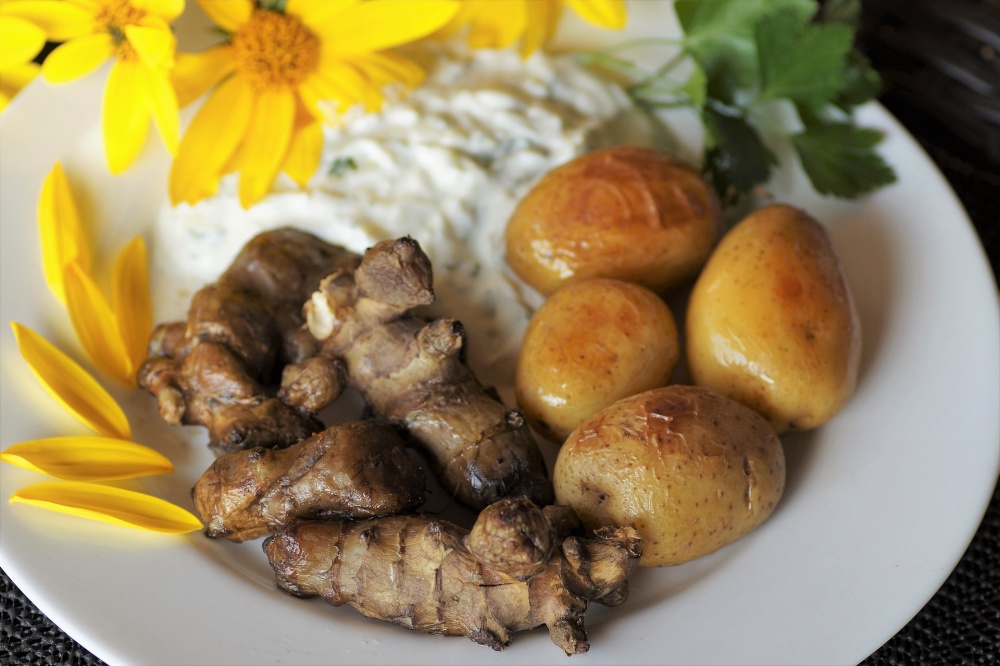
Health use
The fructose that develops in the tubers is a suitable form of energy for persons with diabetes, being low in digestible calories. The cooked tubers are also known to have beneficial bacteria promoting properties and are a good source of potassium, phosphorous, vitamin B1 (thiamine) and iron.
Climate
Although naturally adapted to warm-temperate climates, Jerusalem artichoke grows well and is productive in sub-humid to moderately humid subtropical and tropical highland climates, generally areas with annual lows of 9 to 17°C, annual highs of 15 to 28°C and yearly rainfall of 700 to 1900 mm.
Growing
New plants are usually started from tubers that have been saved from the previous harvest and stored under cool, dark conditions, similar to requirements for other tuber crops. They are sown whole or in pieces when the air humidity builds, just before the rainy season.
Performs best on well-manured, loose, free-draining loam to sandy loam soils of a slightly acid to slightly alkaline nature, generally with a pH of 5.0 to 7.5, and on sites with full to partial sun exposure. Large or oversized containers with ample drainage are also suitable, with good crops of tubers produced. It is intolerant of slow-draining, permanently wet or saturated soil conditions.
The tubers should be ready for harvesting around three to four months after sowing or approximately four to six weeks after the plant has started to flower. Tubers left in the ground and not foraged on by livestock will sprout to form new clumps of plants in the next growing season. The uncooked tubers have a relatively short shelf-life, lasting for around two weeks in the refrigerator.
Problem features
In at least one reference publication, it is listed as an invasive species, a weed classification reserved for the most serious weeds and is recorded as a weed of agriculture in Australia. Its weediness can be attributed to unharvested or missed tubers that re-sprout, forming new clumps of plants that can be difficult to control or eradicate.
Where it grows
References
Books
-
Gohl, B. 1981, Tropical Feeds : feed information summaries and nutritive values (Revised edition), Food and Agriculture Organization of the United Nations (FAO), Rome
-
Hanson, B. 2007, Buried treasures : tasty tubers of the world : how to grown and enjoy root vegetables, tubers, rhizomes, and corms, Brooklyn Botanic Garden, Brooklyn, New York
-
Herklots, G. A. C. 1972, Vegetables in south-east Asia, Allen and Unwin, London
-
Holttum, R. E. & Enoch, I. C. 2010, Gardening in the tropics : the definitive guide for gardeners, Marshall Cavendish Editions, Singapore
-
Hunter, N. T & Mitchell, H. 1994, The art of floral design, Delmar Publishers, Albany, New York
-
Imeson, A. 2010, Food stabilisers, thickeners and gelling agents, Wiley-Blackwell Publishing, Chichester, United Kingdom
-
Morgan, D. & Achilleos, A. 2012, Roots : the definitive compendium with more than 225 recipes, Chronicle Books, San Francisco
-
Norrington, L. & Campbell, C. 2001, Tropical food gardens : a guide to growing fruit, herbs and vegetables in tropical and sub-tropical climates, Bloomings Books, Hawthorn, Victoria
-
Randall, R. P. 2002, A global compendium of weeds, R.G. and F.J. Richardson Press, Melbourne
-
Randall, R. P. 2007, The introduced flora of Australia and its weed status, Cooperative Research Centre for Australian Weed Management, Glen Osmond, South Australia
-
Tindall, H. D 1983, Vegetables in the Tropics, Macmillan Press, London
-
Tindall, H. D. & Rice, L. W. 1990, Fruit and vegetable production in warm climates, International ed., Macmillan, London
-
Toensmeier, E. 2007, Perennial Vegetables : From Artichokes to Zuiki Taro, A Gardener's Guide to Over 100 Delicious and Easy to Grow Edibles, White River Junction, Chelsea Green Publishing, Vermont
-
Winters, H. F & Miskimen, G. W. 1967, Vegetable gardening in the Caribbean area, U.S. Dept of Agriculture, Washington D.C.
